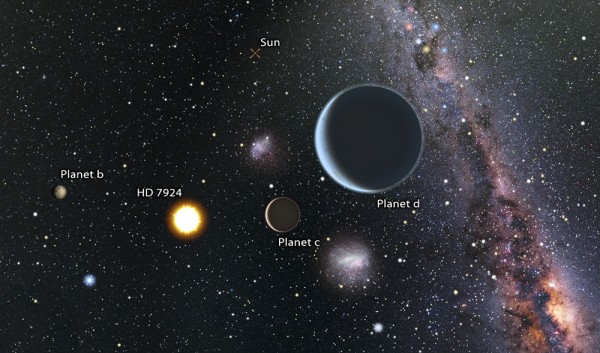Robotic Telescope Discovers Three New Planets Near Earth
| Marco Foronda | | Apr 29, 2015 03:03 AM EDT |
(Photo : Karen Teramura & BJ Fulton, University of Hawaii) Artist’s impression of a view from the HD 7924 planetary system looking back toward our sun, which would be easily visible to the naked eye.
A team of astronomers discovered three new planets in Earth's neighborhood, thanks to a robotic telescope, according to a press release by the University of Hawaii.
Lick Observatory's new telescope, the Automated Planet Finder (APF) discovered Earth's new neighbors, dubbed as super-Earths for having masses about seven to eight times more.
Like Us on Facebook
These super-Earths orbit their host star at a distance closer than the distance between Mercury and our sun. The closest planet completes its orbit in five days while the farthest of them in 24 days, according to the team.
The distance of the host star, called HD 7924, from Earth is 54 lightyears and is considered close enough to be a neighbor.
The APF scans nearby stars to search for small planets in place of the astronomers during the graveyard shift in the station atop Mt. Hamilton. Other telescopes usually detect giants like Jupiter or planets the mass of Neptune, which is 17 times bigger than Earth.
The discovery shows APF's abilities in detecting small planets and doing work for astronomers who do not need to scan the space all night.
Astronomers will be relying more on robotic telescopes in the future, notes Lauren Weiss, one of the lead researchers.
"It's a bit like owning a driverless car that goes planet-shopping," University of Hawaii professor Andrew Howard added.
After this discovery, the APF will do a systematic survey for similar planets orbiting stars within Earth's neighborhood. This will be part of a two-year doctoral dissertation conducted by Benjamin Fulton of the University of Hawaii.
"When the survey is complete we will have a census of small planets orbiting sun-like stars within approximately 100 light-years of Earth," Fulton said.
The team was composed of astronomers from University of Hawaii, University of California Observatories, UC Berkeley, and Tennessee State University.
TagsEarth, planets, super earth, University of Hawaii, Automated Planet Finder, University of California
©2015 Chinatopix All rights reserved. Do not reproduce without permission
EDITOR'S PICKS
-

Did the Trump administration just announce plans for a trade war with ‘hostile’ China and Russia?
-

US Senate passes Taiwan travel bill slammed by China
-

As Yan Sihong’s family grieves, here are other Chinese students who went missing abroad. Some have never been found
-

Beijing blasts Western critics who ‘smear China’ with the term sharp power
-

China Envoy Seeks to Defuse Tensions With U.S. as a Trade War Brews
-

Singapore's Deputy PM Provides Bitcoin Vote of Confidence Amid China's Blanket Bans
-

China warns investors over risks in overseas virtual currency trading
-

Chinese government most trustworthy: survey
-

Kashima Antlers On Course For Back-To-Back Titles
MOST POPULAR
LATEST NEWS
Zhou Yongkang: China's Former Security Chief Sentenced to Life in Prison

China's former Chief of the Ministry of Public Security, Zhou Yongkang, has been given a life sentence after he was found guilty of abusing his office, bribery and deliberately ... Full Article
TRENDING STORY

China Pork Prices Expected to Stabilize As The Supplies Recover

Elephone P9000 Smartphone is now on Sale on Amazon India

There's a Big Chance Cliffhangers Won't Still Be Resolved When Grey's Anatomy Season 13 Returns

Supreme Court Ruled on Samsung vs Apple Dispute for Patent Infringement

Microsoft Surface Pro 5 Rumors and Release Date: What is the Latest?










